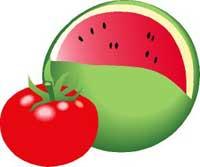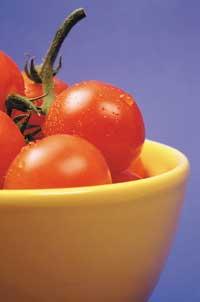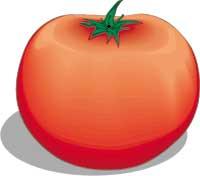Antioxidant power of lycopene
2002/09/01 Lorenzo, Arantza | Uranga, Ane Miren Iturria: Elhuyar aldizkaria
Under normal physiological conditions, oxidant stress occurs in all living organisms, oxidation phenomena in cells and tissues. These processes, under normal conditions, are controlled by antioxidant systems. However, when an imbalance occurs between oxidant and antioxidant systems, the risk of chronic and degenerative diseases, such as cancer and heart disease, is usually higher.
The most common oxidation reactions consist of the formation of radical and reactive oxygens (called free radicals) that can cause transformations in DNA.

These oxidizers, internal or external to the body (tobacco smoke, solar rays, ionizing radiations, etc.) can be. In order to protect our health before all of them, we will need to incorporate antioxidants through our daily diet.
Antioxidants inhibit these oxidation reactions and block radicals derived from oxygen. The best known antioxidants today are some vitamins (alpha-tokoferoles or E, beta-carotene or A and C) and some trace elements (selenium, copper and zinc).
Lycopene is a natural carotenoid that does not become vitamin A. That's what gives red color to some fruits and vegetables. As the plant matures, the levels of chlorophyll are decreasing and the viscotopos, mainly, and other carotenes, to a lesser extent, acquire predominance. They are the ones that give color and brightness to the plant.
As for its physical characteristics, lycopene is more soluble in organic solvents (ether, chloroform, etc.) that in water. And its antioxidant power is due to its chemical structure, with numerous double links that facilitate the search for oxygen free radicals of enormous oxidizing power. In addition, lycopene participates in the control of cell development. When there is no lycopene, the cells grow more confused.
Lycopene is found primarily in the human body, testicles, prostate, adrenal glands, and liver. To a lesser degree, in breasts, arenas, lungs, skin, etc.
We did not find lycopene in many foods, with tomato being the richest source of this substance (0.7-20 mg/100 g). Watermelon (2.30-7.20 mg/100 g), guava (5.23-5.50 mg/100 g) and papaya (0.11-5.30 mg/100 g) also contain it in part.
However, the amount of lycopene of these foods varies depending on their maturity, degree of transformation, etc.
In addition, contrary to what happens with many other foods, after the heating of the food increases the bioavailability of the viscope, that is, the lycopene of the tomato subjected to the culinary process becomes a more effective isomer. The tomato in detail has the same effect. On the other hand, the association of lipids and viscotopes in our diet facilitates the dissolution of the latter and facilitates its intestinal absorption. Therefore, lycopene is more beneficial when we heat or make tomato with oil, and the ability of lycopene to prevent cancer and heart disease is more effective.
Tomato Tomato Tomato
This basic element of the Mediterranean diet comes from Mexico XVI. The twentieth century, however, passed more than 200 years before its approval throughout France, Germany and Northern Europe.
Fresh tomato contains almost 94% water, but also contains carbohydrates (3.54%), proteins (0.85%) and fats (0.33%). It is a food that provides very little energy (21 Kcal/100 g). In addition, it contains water-soluble fiber (1.1%), which increases intestinal mobility and reduces blood cholesterol levels.
However, it is so rich in mineral salts, vitamins and phytochemical substances it provides.

The most abundant vitamin is vitamin C (19.1 mg/100 g). Orange has less than 53.2 mg/100 g, but with a tomato we get a third of the vitamin C we need daily. It also contains important amounts of B1, B2, B6, niacin, folic acid and probitamine A.
The main phytochemical substances found in tomato are:
- Organic acids: malic and oxalic. As the tomato arrives, it decreases the acid and increases the amount of sugar.
- Lycopene.
For these characteristics, it is very beneficial for everyone to eat tomato, of various forms (raw in salads, tomato juice, tomato sauce...) and especially recommended in:
- In prostate diseases: A study by Harvard University reveals that the risk of prostate cancer is very low for men who consume a typical tomato diet. This carotene, which appears in large quantity in the tomato, helps to grow well prostate cells and protects them from oxidation. In this way, the correct functioning of this organ is produced.
- It has a cleansing function in the problems of the kidney: the tomato causes the alkalinization of the blood and helps to remove the acidic metabolic residues. Therefore, it is very important to consume tomato when gout (excess uric acid) or the level of urea in the blood is high, as it facilitates the work of the kidneys.
- In cases of defenselessness: due to its high content in vitamins, mineral salts and, above all, carotene antioxidants, tomato is a natural stimulant of immune functions and adds defenses.
- Arteriosclerosis and circulatory diseases: tomato acts as an antioxidant and prevents the oxidation of cholesterol. Consequently, it participates in the prevention of traffic and heart problems.
- Cancer prevention: in addition to prostate cancer, in general of the cancers of the digestive system (mouth, esophagus, stomach, etc.) It protects us.
Below are two known proposals in the Mediterranean diet to best take advantage of the lycopene of tomato and, in general, all its properties:
- Gazpacho: it can be prepared in a thousand ways, but the basic ingredient is always tomato. Then, according to local customs, garlic, cucumber, bread, olive oil is added...
- 'Pa amb tomaquet' (bread with tomato): Catalan gastronomic dish. Spread the bread two centimeters thick with a mature tomato and add a little salt and olive oil. This recipe includes in a very adequate way the essence of the Mediterranean diet.
These two dishes, in addition to sweets, are an excellent source of health for all the exposed.

Gai honi buruzko eduki gehiago
Elhuyarrek garatutako teknologia





